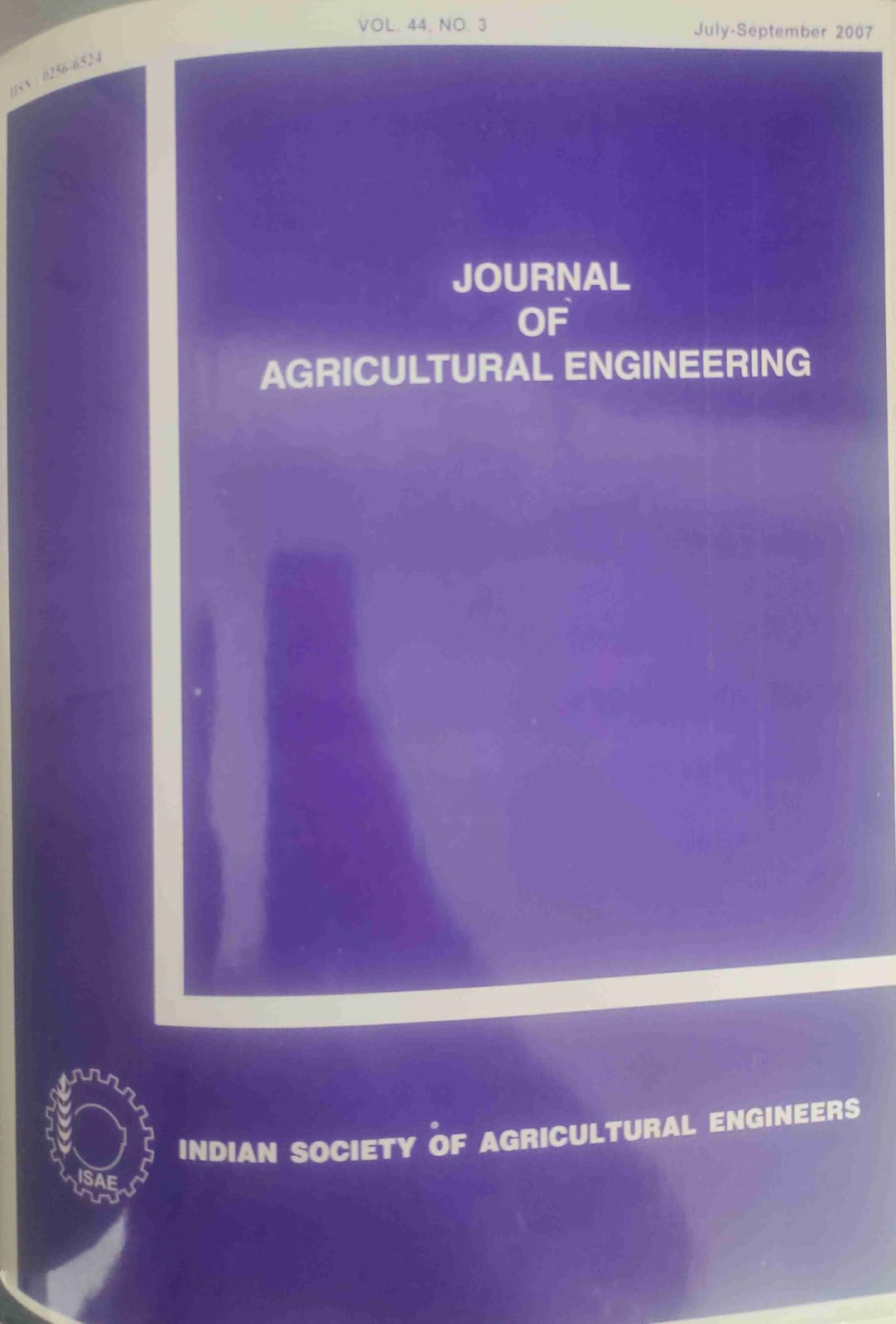Dynamic Crop Planning for Enhancing the Crop Productivity Under Rainfed Conditions
DOI:
https://doi.org/10.52151/jae2007443.1283Abstract
Rainfall data of Bhilwara district in Rajasthan state for a period of45 years were analysed from two approaches viz.; 'Meteorological' approach and 'Onset of monsoon' approach. The results revealed considerable difference in rainfall characteristics with respect to length of growing period, water surplus/ deficit and probability of intervening dry spells due to these approaches. The 'Onset of monsoon' approach is more rational as it precisely describes the actual crop environment and provides information for varying onsets of monsoon as compared to 'Meteorological' approach. The results of water balance study revealed an increase of 142.6% in water deficit due to delay in onset (31 51 SMW) as compared to normal onset of monsoon (27th SMW), whereas an increase of 35.2% and decrease of 33.7% in water surplus was recorded due to late and early onset of monsoon. The correlation studies also reveal that onset of monsoon is inversely correlated (-0.91) with duration of rainy season while positively correlated (0.83) with water deficit. Thus, the 'onset of monsoon' approach should be considered for crop planning under rainfed regions to harness more profit per unit of rainfall.
References
Agnihotri Y; Murti R. 2001. Relationship between onset of monsoon with sowing weeks and monthly! Seasonal rainfall at Chandigarh. J. Indian Water Reso. Soc., 21 (2), 60-64.
Allen R G; Pereira I S; Oaes 0; Smith M. 1998. Crop evapotranspiration, Guideline for Computing Crop Water Requirements. FAO Irrig. and Drain, Paper 56. Rome, Italy.
Anonymous. 2004. Annual reports from 1985-2004. AICRP on Dryland Agriculture, Dryland Farming Research Station, Arjia, Bhilwara (Rajasthan).
Deora B S. 2005. Modelling of Drought under different Agro-climatic Zones of Gujarat Maharashtra. Unpublished Ph. D. Thesis. Deptt. of Soil and Water Engg. CTAE, MPUAT, Udaipur.
Outta 0; Tapati Banerjee; Sarkar Dipak. 2006. Climatic characteristics and crop planning-A case study in Birbhum district ofWest Bengal. Indian J. Soil Cons., 34(2), 167-69.
Hooda B K. 2006. Probability analysis of monthly rainfal1 for agricultural planning. Indian J. Soil Cons., 34(1), 12-14.
Jain B L; Singh R S; Shyampura R L; Velayuthan M. 2000. Agroecological Assessment of Soil Resources of Rajasthan for Land Use Planning. NBSS LUP technical bulletin no. ISBN: 81-85460-56-6, Nagpur.
Jat M L; Singh R V; Balyan J K; Jain L K. 2005. Rainfall analysis for crop planning in Udaipur region. Indian J. Soil Cons., 33(3), 264-266.
Morris R A; Zandstra H G. 1979. Land and climatic in relation to cropping patterns. In rainfed low land rice, selected papers from 1970. Int. Rice Res. Conf. IRRI., 255-274.
Pandarinath N. 1991. Markov Chain model probability of dry and wet weeks during monsoon period over Andhra Pradesh. Mausam, 42(4), 393-400.
Panigrahi B; Panda S N. 2002. Dry spell probability by Markov Chain model and its application to crop planning. Indian J. Soil Cons., 30(1), 95-100
Robertson G W. 1976. Dry and wet spel1 UNDPIFAO, Tun RazakAgric. Res., Center, Sungh: Tekam, Malaysia Project field report, Agrometeorology. A-6. 15.
Saha R; Mishra V K. 2005. Probability analysis of rainfal1 at Meghalaya for crop planning. Indian J. Soil Cons., 33(1), 86-87.
Satpute G U. 2004. Characterization of Drought under different Agro-climatic Zones of Maharashtra. Unpublished Ph. D. Thesis, Deptt. of Soil and Water Engg. CTAE, MPUAT, Udaipur.
Singh J B; Hazra C R. 1999. Rainfall characteristics of Jhansi for crop planning under rainfed condition- A decadal change. J. Soil Water Cons., (43), 25-34.
Singh P K. 2005. Rainfall variability and crop planning in Sabour region of Bihar. J. Agrometeorology, 7(2), 284-290.
Singh S P; Hundal S S; Aluja M S. 2004. Dry and wet spell sequences for crop planning at Bathinda, Punjab-A Markov chain approach. J. Agrometeorology, 6(Sp.62 Issue), 242-246.
Stewart J. 1991. Principles and performance of response farming. In: Climatic risks in crop productions- Modelsand management for semiarid tropics and subtropics (Russcell C. Muchow and JenniferA. Bellamy Ed.), CAB International, United Kingdom.
Thornthwaite C W; Mather J R. 1955. The Water Balance Climate. 8(1). Dreseal Inst. of Tech., New Jersey. USA.














